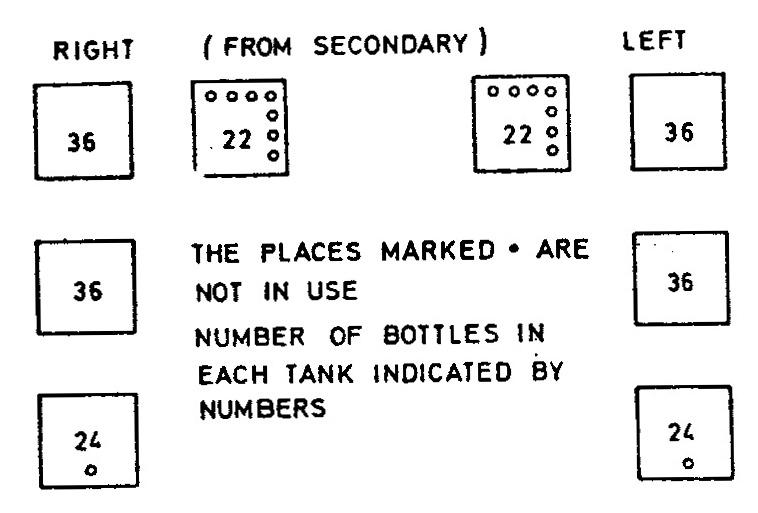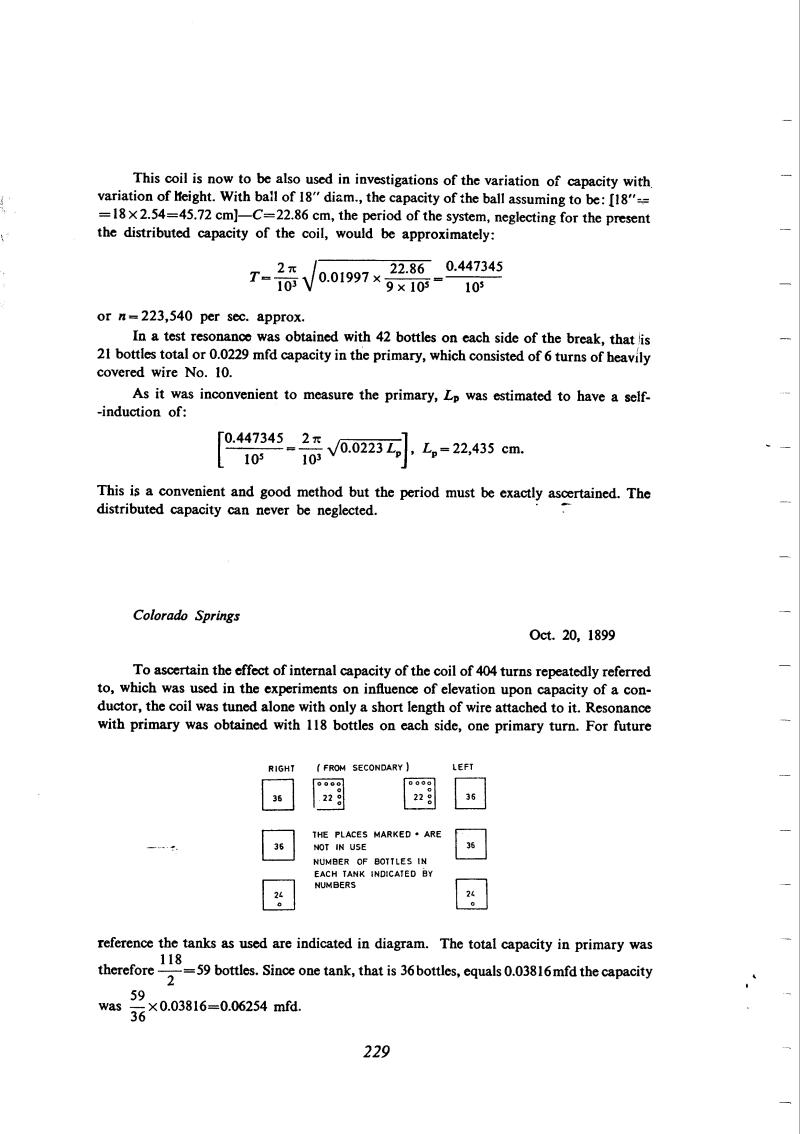
Nikola Tesla Books
This coil is now to be also used in investigations of the variation of capacity with variation of height. With ball of 18" diam., the capacity of the ball assuming to be: [18" = 18 x 2.54 = 45.72 cm] - C = 22.86 cm, the period of the system, neglecting for the present the distributed capacity of the coil, would be approximately:
$! {T = {{2 \pi \over 10^{3}} \sqrt{0.01997 \times {22.86 \over {9 \times 10^{5}}}}} = {0.447345 \over 10^{5}}} $!
or n = 223,540 per sec. approx.
In a test resonance was obtained with 42 bottles on each side of the break, that is 21 bottles total or 0.0229 mfd capacity in the primary, which consisted of 6 turns of heavily covered wire No. 10.
As it was inconvenient to measure the primary, Lp was estimated to have a self-induction of:
$! {{\left[{{0.447345 \over 10^{5}} = {{2 \pi \over 10^{3}} \sqrt{0.0223 L_{p}}}}\right]}, L_{p} = 22,435} $! cm.
This is a convenient and good method but the period must be exactly ascertained. The distributed capacity can never be neglected.
Colorado Springs
Oct. 20, 1899
To ascertain the effect of internal capacity of the coil of 404 turns repeatedly referred to, which was used in the experiments on influence of elevation upon capacity of a conductor, the coil was tuned alone with only a short length of wire attached to it. Resonance with primary was obtained with 118 bottles on each side, one primary turn. For future reference the tanks as used are indicated in diagram.
The total capacity in primary was therefore $! {118 \over 2} $! = 59 bottles. Since one tank, that is 36 bottles, equals 0.03816 mfd the capacity was $! {59 \over 36} $! x 0.03816 = 0.06254 mfd.
229
October 19
He rewinds the "experimental" coil by means of which he tested the wave propagation through the ground in the beginning of Sept. Now the rewound coil is to be used for sphere capacitance variation measurement with regard to elevated height variation. He calculates the rewound coil inductance (by means of equations for an infinitely long coil which he uses as a rule) and with the sphere of a certain diameter he calculates the system period. He neglects the coil distributed capacitances.
At the end he performs the experiment with the oscillator but it seems that he used only standard primary capacitors (jars) and he made the primary from several turns of thick wire. That is why the primary inductance appears as an unknown value.
October 20
Tesla was measuring the capacity of the coil which he had used for determining the change of capacity of a sphere with height (up till October 9th he had called it a âspecial coilâ). Considering the dimensions of the primary (coil diameter 15 m) and the coil being tested (diameter 64 cm, length 145 cm), the coupling between them was obviously loose, so that the frequency found from the parameters of the primary circuit (provided that the main secondary of the oscillator did not influence the oscillation of the primary) can now be accepted as accurate. It is not stated how resonance was determined, but it was probably from the sparks at the terminals of the test coil. Similar resonance methods are given in recent textbooks on electrical measurements(56). It must be noted, however, that determination of the distributed capacity of a coil from the resonance of the coil alone is not reliable, it depends on the mode of excitation and always gives lower values. It is therefore recommended to measure it with an added lumped capacity in the circuit.
October 20
He describes the measurement method for the determination of the coil distributed capacitance. The measurements are performed on a coil which is used for the determination of sphere capacitance variation with height (until October 4 this coil is named "special coil"). The coil with additional short wire he excites without having a galvanic connection with the oscillator circuit. Based on primary dimensions (coil 15 meters diameter) and the tested coil dimensions (64 cm diameter by 145 cm length) it is obvious that the coupling between them must be weak. Therefore, we can accept the accuracy of the found frequency on the basis of primary circuit parameters (on the condition that the oscillator main secondary circuit does not influence the primary operation). It was not mentioned how resonance is determined, but it could be assumed that this was done on the basis of spark length at the terminals of the tested coil*.
We are under the impression that Tesla is suspicious of the 'as found' values of the coil's distributed capacitances. He worked hard on further proofs of the measured value by searching for new methods of determination.
* Similar resonant methods are given even in today's text books on electrical measurement(56). It is mentioned however, that the determination of coil distributed capacitance on the basis of the coil self resonance is not reliable, because it depends on the excitation method and always provides lower values. Because of this it is recommended to measure this capacitance when additional capacitance in the circuit exists.


